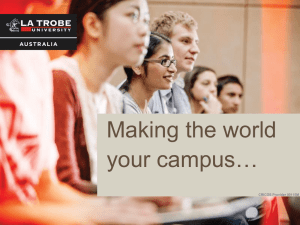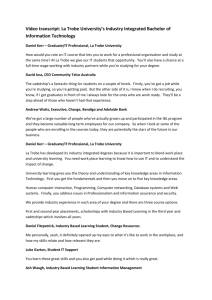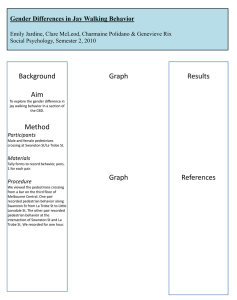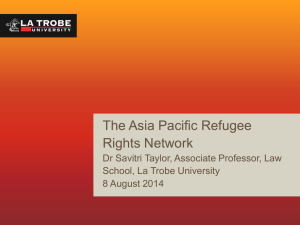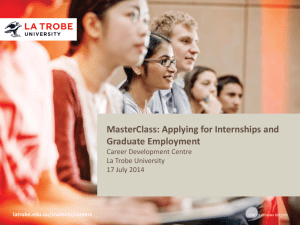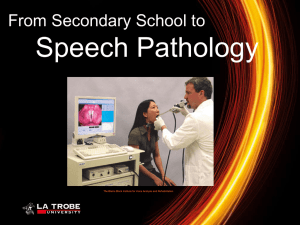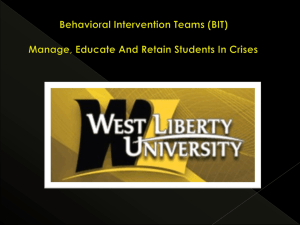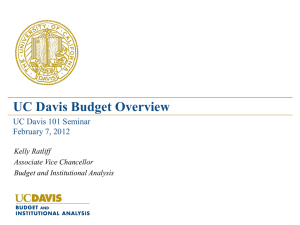Redefining engagement - Higher Education Academy
advertisement
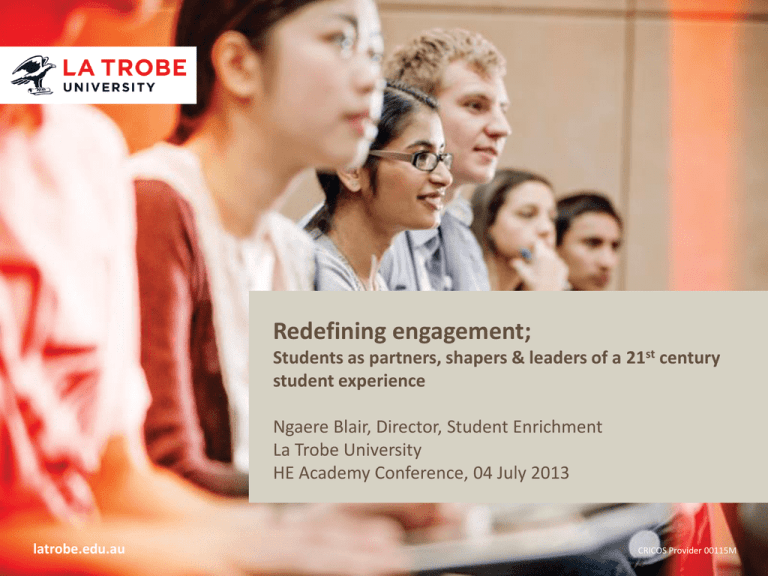
Title of presentation Redefining engagement; Students Name of presenter as partners, shapers & leaders of a 21st century Title of presenter student experience School / Faculty / Division Ngaere Blair, Director, Student Enrichment xx Month 201x La Trobe University HE Academy Conference, 04 July 2013 latrobe.edu.au CRICOS Provider 00115M About La Trobe University • Established in 1967 as a progressive alternative to established institutions. • Strong ethos on social justice, access and equity and regional community. engagement. • Multi-campus, with main campus in the northern suburbs of Melbourne and smaller campuses spread across regional Victoria (largest regional provider in the state). • Over 33,000 students enrolled with 19,000 at main campus in Melbourne and between 200- 4,000 at regional campuses. • Over 17% of students are from low socio-economic backgrounds. 46% are first in their families to attend higher education. • Nearly 5,000 international students, mainly drawn from India, China, South America, UK and USA. La Trobe University 2 La Trobe University 3 Mildura campus, 200 students Wodonga campus, 800 students Shepparton campus, 200 students Bendigo campus, 4,000 students Main campus, 19,000 students La Trobe University 4 A changing sector Review of Australian Higher Education in 2008; • Increase enrolments of low socio-economic students to 40% by 2020 (currently 15%). • Increase all enrolments by 30% by 2020. • Remove caps on places and increase competition between Unis. • Make explicit that student satisfaction and student experience will be used as quality indicators and data will be publicly available. • Re-introduction of ‘student amenities’ fees allowing student unions to rebuild. But then.... • Demand from international students has declined (high $AU). • In May 2013, Govt announced funding cuts of over $2Bil. • Current Govt likely to lose September election. • MOOCS! La Trobe University 5 A 21st century student experience It can be argued.... • The role Universities play in the lives of their students is changing. • University is just one of a portfolio of commitments. • Students have constant access to information, ideas and opinions. • A degree no longer sets graduates apart. • Students, parents and employers question the relevance, value and quality of higher education. In a 21st century student experience ‘do we have students, or are they customers, stakeholders, constituents, or (indeed) products?’ (Birnbaum, 1998) La Trobe University 6 How should we view our students? As Customers? • Does this mean we are expected to ‘pander’ to student satisfaction? (Winter and O’Donohue, 2012; Mark, 2013). However... • ‘Customers are no longer viewed as passive recipients, but as active participants in service delivery and co-producers of the services they receive’ (Mark, 2013). Co-producers/Co-creators? • Digital knowledge; students can now source and shape content, collaborate, and provide and expect instant feedback (Sternberg, 2012; Gregory et al, 2010). • ‘The key to dealing with students evolving learning styles, considerable, but inconsistent, technological expertise and increasing diversity [is in] a renegotiation of the student/teacher relationship in which both parties are recognised as ‘cocreators’ of knowledge’. (Sternberg, 2012) La Trobe University 7 How should we view our students? As Partners? • Students are often the best change agents with the most knowledge to offer on what effective learning experiences look like. • 'Engaging students as partners in change also means tolerance for multiple perspectives, different talents, and diversity. [We] cannot be certain of what specific talents, knowledge, and skills will be of value, and globalization has expanded the market' (Zhao, 2011). All of the above? • Student inhabit each of these roles- and others- at some point and to varied extents (Sharrock, 2013). • Partnerships, collaborations and customer relationships are all invested with heavy expectations, unrealistic demands and disappointments, but they can also be mutually beneficial, rewarding, dynamic, and constructive when given the opportunity. La Trobe University 8 What makes a good student experience? •Quality courses, engaging teaching and career pathways. •Interaction with teaching staff and discussion on course and career choice. •Flexible learning spaces, library and IT support. •An accessible and sophisticated online learning environment. •Responsive administrative and student support services. •Being treated as an individual and valued as a student. •Physical places and facilities that allow informal socialisation. •Social and peer support and the opportunity to build learning communities. •Access to extra-curricular activities such as clubs and societies. •A welcoming and inclusive environment. •Engaging with difference and diversity. •Challenging and relevant academic experiences. (Kuh, 2005; Coates, 2009; Tinto, 1987, Pascarella & Terenzini, 2005) La Trobe University 9 Why does the student experience matter to Universities? • Integral to high quality teaching and learning • Widening participation; more students coming with varied backgrounds and preparedness, but those who feel supported will thrive • Public policy; in a demand-driven system, students have more choice and are encouraged to ‘shop around’ • International student market becoming more competitive (plus high $AU) • Students talk… social media platforms such as Twitter, Facebook, Pinterest, StalkerSpace….these can be powerful aids or hindrances to our reputation • Quality Assurance ‘places a renewed emphasis on student outcomes and the quality of the student experience’. • Universities have a role to play in the education of knowledgeable, adept, and well rounded future leaders who will be faced with growing social, cultural, environmental and economic challenges La Trobe University 10 Measuring the student experience Institutional tools National benchmarking tools •Retention Rates. •Australasian Universities Survey of Student Engagement. •Participation Rates. •Exit Interviews. •University Experience Survey. •Student Services Satisfaction. •First Year in Higher Education Survey. •Completion Rates. •TEQSA reporting (QA). •Alumni Surveys. •Communication Channels/Feedback. •Australian Graduate Survey (Employment Outcomes & Course Experience). •Student Cohort profiles (e.g., age, residency, SES, ATAR, equity). •Beyond Graduation Survey. •Focus groups. •Market research. ‘It’s your data. You have an inherent right to it. It should be used first to help you in your learning journey.’ (Milliron, 2012) La Trobe University 11 The project (a work in progress) Aim: To engage students as partners in determining how the University values and prioritises the La Trobe student experience. Process: 1. Identify a methodology that groups student experience concepts by a theme that is logical, underpinned by student engagement theory, and for which we are likely to have evidence. 2. Consultation with students to identify what aspects of the student experience most matters to them. 3. Review existing data sources that provide evidence of student’s outcomes, participation, satisfaction and engagement within those themes. 4. Develop a ‘dashboard’ that demonstrates how the University performs against the identified indicators. 5. Engage students in further consultation on how to improve on low performing areas through a series of student experience ‘summits’ La Trobe University 12 Framing the student experience Lizzio’s ‘5 Senses’ Model (2006) Sense of Connectedness Sense of Capability •Institutional identification •Community participation •Student-Staff relationships •Task and role clarity •Student-Student relationships •Academic competence Sense of Culture •Clear values La Trobe University Sense of Resourcefulness Sense of Purpose •University-life interface •Disciplinary engagement •Physical environment •Vocational direction •Systems access and navigation •Personal development 13 Engaging students as partners La Trobe University 14 La Trobe University 15 Reporting on results Lizzio theme: Vocational Direction/Sense of Purpose Acquiring job related or work related skills or knowledge (AUSSE 2011) 90% 80% 70% 60% Very little/some 50% Quite a bit/Very much 40% 30% 20% 10% 0% LTU Students La Trobe University LTU Staff Benchmark 16 Framing the student experience Lizzio’s ‘5 Senses’ Model (2006) Sense of Connectedness Sense of Capability •Institutional identification •Community participation •Student-Staff relationships •Task and role clarity •Student-Student relationships •Academic competence Sense of Culture •Clear values La Trobe University Sense of Resourcefulness Sense of Purpose •University-life interface •Disciplinary engagement •Physical environment •Vocational direction •Systems access and navigation •Personal development 17 What is important to students? Feeling challenged & engaged Fitting in and making friends La Trobe University 18 What is important to students? Access to study resources La Trobe University Cheap car parking 19 What is important to students? Cheap car parking Access to study resourcesAccomplishing goals La Trobe University 20 Thank you Ngaere Blair Director, Student Enrichment La Trobe University AUSTRALIA E: n.blair@latrobe.edu.au T: + 61 3 9479 3425 latrobe.edu.au CRICOS Provider 00115M References Birnbaum, R. (1998), How colleges work; the cybernetics of academic organization and leadership. Jossey Bass, San Francisco, (pp.225-226) Coates, H., Radloff, A., James, R., Krause, K. (2011). Report on the Development of the University Experience Survey. Canberra, Australia: Commonwealth of Australia. Retrieved from: www.deewr.gov.au/HigherEducation/Policy/Pages/UniversityExperienceSurvey.aspx de Lourdes Machado, M., Brites, R., Magalhães, A. and Sá, M. J. (2011). Satisfaction with higher education: critical data for student development. European Journal of Education, 46(3), 415-432. Gregory, S., Gregory, B., Campbell, M., Farley, H., Sinnappan, S., Kennedy-Clark, S., Craven, D., Murdoch, D., Lee M.J.W., Wood, D., Grenfell, J., Thomas, A., Smith, K., Warren, I., Dreber, H., McKeown, L., Ellis, A., Hillier, M., Pace, S., Cram, A., Hay, L., Grant, S., Matthews, C. (2010). Australian higher education institutions transforming the future of teaching and learning through 3D virtual worlds. Paper presented at proceedings ascilite Sydney 2010. Retrieved from http://www.ascilite.org.au/conferences/sydney10/procs/Gregory-full.pdf Kuh, G., Kinzie, J., Schuh, J. H., Whitt, E. (2005). Assessing conditions to enhance educational effectiveness; the inventory for student engagement and success. San Francisco, America: Jossey-Bass. Lizzio, A. (2006). Designing an orientation and transition strategy for commencing students, Griffith University First Year Experience Project Mark, E. (2013): Student satisfaction and the customer focus in higher education. Journal of Higher Education Policy and Management, 35:1, 2-10 Milliron, D., (2012). An open to letter to students; you are the game changer in next-generation learning. EDUCAUSE Review,47(4) . Retrieved from: www.educause.edu/ero/article/open-letter-students-youre-game-changer-next-generation-learning Sternberg J. (2012): ‘It's the end of the university as we know it (and I feel fine)’: the Generation Y student in higher education discourse. Higher Education Research & Development, 31:4, pp.571-583 Tinto, V. (1993). Leaving college: Rethinking the causes and cures of student attrition. Chicago: University of Chicago Press Winter, R.P., O’Donohue, W. (2012). Academic identity tensions in the public university; which values really matter? Journal of Higher Education Policy and Management, 34(6), pp. 565-573 Zhao, Y. (2011). Students as change partners: A proposal for educational change in the age of globalisation. Journal of Educational Change, 12, pp.267–279
